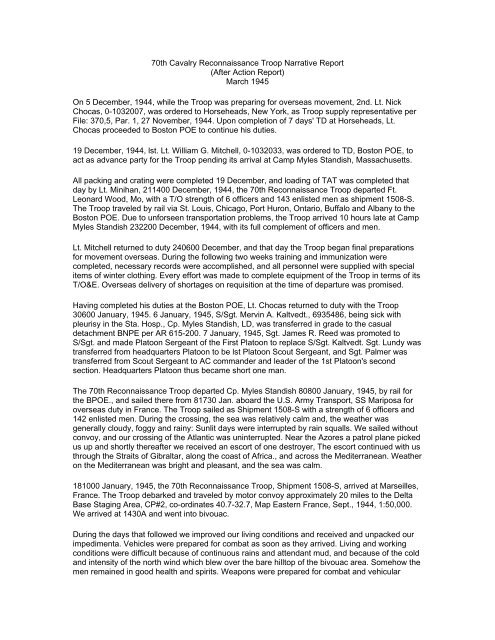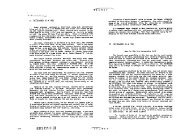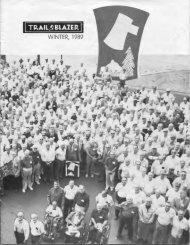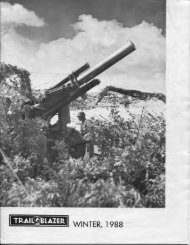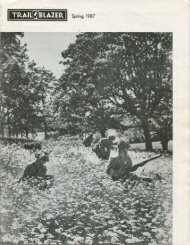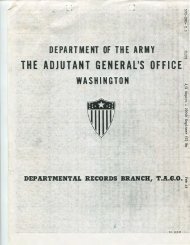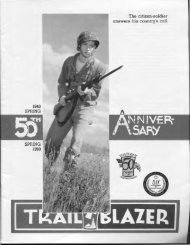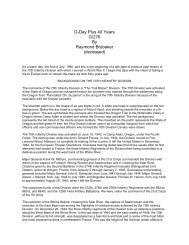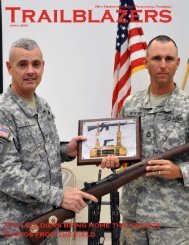70th Cavalry Reconnaissance Troop Narrative Report - 70th Infantry ...
70th Cavalry Reconnaissance Troop Narrative Report - 70th Infantry ...
70th Cavalry Reconnaissance Troop Narrative Report - 70th Infantry ...
Create successful ePaper yourself
Turn your PDF publications into a flip-book with our unique Google optimized e-Paper software.
<strong>70th</strong> <strong>Cavalry</strong> <strong>Reconnaissance</strong> <strong>Troop</strong> <strong>Narrative</strong> <strong>Report</strong><br />
(After Action <strong>Report</strong>)<br />
March 1945<br />
On 5 December, 1944, while the <strong>Troop</strong> was preparing for overseas movement, 2nd. Lt. Nick<br />
Chocas, 0-1032007, was ordered to Horseheads, New York, as <strong>Troop</strong> supply representative per<br />
File: 370,5, Par. 1, 27 November, 1944. Upon completion of 7 days' TD at Horseheads, Lt.<br />
Chocas proceeded to Boston POE to continue his duties.<br />
19 December, 1944, lst. Lt. William G. Mitchell, 0-1032033, was ordered to TD, Boston POE, to<br />
act as advance party for the <strong>Troop</strong> pending its arrival at Camp Myles Standish, Massachusetts.<br />
All packing and crating were completed 19 December, and loading of TAT was completed that<br />
day by Lt. Minihan, 211400 December, 1944, the <strong>70th</strong> <strong>Reconnaissance</strong> <strong>Troop</strong> departed Ft.<br />
Leonard Wood, Mo, with a T/O strength of 6 officers and 143 enlisted men as shipment 1508-S.<br />
The <strong>Troop</strong> traveled by rail via St. Louis, Chicago, Port Huron, Ontario, Buffalo and Albany to the<br />
Boston POE. Due to unforseen transportation problems, the <strong>Troop</strong> arrived 10 hours late at Camp<br />
Myles Standish 232200 December, 1944, with its full complement of officers and men.<br />
Lt. Mitchell returned to duty 240600 December, and that day the <strong>Troop</strong> began final preparations<br />
for movement overseas. During the following two weeks training and immunization were<br />
completed, necessary records were accomplished, and all personnel were supplied with special<br />
items of winter clothing. Every effort was made to complete equipment of the <strong>Troop</strong> in terms of its<br />
T/O&E. Overseas delivery of shortages on requisition at the time of departure was promised.<br />
Having completed his duties at the Boston POE, Lt. Chocas returned to duty with the <strong>Troop</strong><br />
30600 January, 1945. 6 January, 1945, S/Sgt. Mervin A. Kaltvedt., 6935486, being sick with<br />
pleurisy in the Sta. Hosp., Cp. Myles Standish, LD, was transferred in grade to the casual<br />
detachment BNPE per AR 615-200. 7 January, 1945, Sgt. James R. Reed was promoted to<br />
S/Sgt. and made Platoon Sergeant of the First Platoon to replace S/Sgt. Kaltvedt. Sgt. Lundy was<br />
transferred from headquarters Platoon to be lst Platoon Scout Sergeant, and Sgt. Palmer was<br />
transferred from Scout Sergeant to AC commander and leader of the 1st Platoon's second<br />
section. Headquarters Platoon thus became short one man.<br />
The <strong>70th</strong> <strong>Reconnaissance</strong> <strong>Troop</strong> departed Cp. Myles Standish 80800 January, 1945, by rail for<br />
the BPOE., and sailed there from 81730 Jan. aboard the U.S. Army Transport, SS Mariposa for<br />
overseas duty in France. The <strong>Troop</strong> sailed as Shipment 1508-S with a strength of 6 officers and<br />
142 enlisted men. During the crossing, the sea was relatively calm and, the weather was<br />
generally cloudy, foggy and rainy: Sunlit days were interrupted by rain squalls. We sailed without<br />
convoy, and our crossing of the Atlantic was uninterrupted. Near the Azores a patrol plane picked<br />
us up and shortly thereafter we received an escort of one destroyer, The escort continued with us<br />
through the Straits of Gibraltar, along the coast of Africa., and across the Mediterranean. Weather<br />
on the Mediterranean was bright and pleasant, and the sea was calm.<br />
181000 January, 1945, the <strong>70th</strong> <strong>Reconnaissance</strong> <strong>Troop</strong>, Shipment 1508-S, arrived at Marseilles,<br />
France. The <strong>Troop</strong> debarked and traveled by motor convoy approximately 20 miles to the Delta<br />
Base Staging Area, CP#2, co-ordinates 40.7-32.7, Map Eastern France, Sept., 1944, 1:50,000.<br />
We arrived at 1430A and went into bivouac.<br />
During the days that followed we improved our living conditions and received and unpacked our<br />
impedimenta. Vehicles were prepared for combat as soon as they arrived. Living and working<br />
conditions were difficult because of continuous rains and attendant mud, and because of the cold<br />
and intensity of the north wind which blew over the bare hilltop of the bivouac area. Somehow the<br />
men remained in good health and spirits. Weapons were prepared for combat and vehicular
weapons were mounted. Radios were tested and installed. Ammunition was received and issued.<br />
T/E shortages due to unfilled requisitions and losses in transit were placed on requisition. The<br />
reconnaissance platoons undertook training in foreign map reading and in vehicular<br />
reconnaissance as soon as their equipment was ready. <strong>Troop</strong> preparation was needlessly<br />
delayed because of repairs to and replacement of equipment made necessary by the exceedingly<br />
careless handling of equipment by dock personnel at Marseilles during unloading of the ship<br />
bearing our impedimenta.<br />
30 January, 1945, the <strong>Troop</strong> received three medical corpsmen to be attached unassigned for duty<br />
and administration from Hq. Spcl. Trs., 70 Inf. Div. per VOCG 70 Inf. Div. as follows: Hood,<br />
Charles R. 34143334, Cpl., MOS 861; Colman, Carl B., 391374333 T/5, MOS 861; Haman,<br />
Wilhelm, 38131270, T/5, MOS 409.<br />
The night of 1 February., 1945, Pvts., Hamm., T. J., and Gillum, James C., were injured in a<br />
vehicular accident while enroute to the Staging Area from Marseilles and were evacuated to the<br />
<strong>70th</strong> Sta. Hosp., Marseilles, sick, LD. 2 February Pvt. Hamm returned to duty. Pvt. Gillum<br />
remained in the hospital and was subsequently dropped.<br />
The <strong>Troop</strong> broke its bivouac 3 February, 1945, and made ready for a motor march to the <strong>70th</strong><br />
Div. front. Cold rain and fog beset us the night of 3-4 February and we moved out 40740<br />
February in dense fog over muddy roads to Aix en Provence. The <strong>Troop</strong> moved in two march<br />
units, one commanded by Lt. Mitchell and one by Lt. Koefod. Two AG M8's with crews were<br />
attached to the 270 Engineers for purposes of the march. One attached M8 developed motor<br />
trouble and was left behind by the Engineers to be towed to Marseilles for repairs. That M8.,<br />
commanded by Sgt. Cicio, rejoined the <strong>Troop</strong> at Freyming 10 February.<br />
3 February, 1945, the <strong>Troop</strong>'s five half-tracks, each loaded with <strong>Troop</strong> equipment, were put<br />
aboard flatcars in Marseilles for shipment by rail. A detail of 25 men under Lt. Minihan<br />
accompanied them and joined us in Freyming. Enroute, one half-track was detached from the<br />
train and returned to Marseilles because the flatcar bearing it developed a hot-box and was in<br />
danger of being destroyed by fire. The detached half-track was subsequently re-shipped from<br />
Marseilles and last heard of at Blaineville: It is considered lost in transit. Lt. Minihand and his<br />
detail departed Marseilles 4 February.<br />
At the close of the first day's march, the <strong>Troop</strong> bivouaced for the night at St. Rambert Airfield, St.<br />
Rambert, France, at 18OO. A 9 ton track driven by Pvt. Slyzinski dropped out of convoy during<br />
the afternoon of 4 February due to a breakdown. It was brought up during the night and<br />
forwarded to the 901st Ordnance Co., Lyon, for repairs. T/4 Monthey, T/4 Sheets and T/5<br />
McCaslan accompanied the truck to effect repairs and to drive the truck to our destination. En<br />
route they were misdirected and nearly drove into the German lines at Sasreguemines: They<br />
were turned back at the Saar River bridge by American soldiers on guard.<br />
50800 February the <strong>Troop</strong> resumed its march to the North and made bivouac that night at Dijon,<br />
France. The day's march was made in fog and rain over muddy roads without incident. Bivouac<br />
was without benefit of shelter in snow and slush in a city park during a night of light rain.<br />
60800 February the <strong>Troop</strong> departed Dijon for Epinal, arriving there at 1400 to refuel before going<br />
into bivouac at 1700. Cover for the night was provided in a textile mill furnished by its local owner.<br />
The <strong>Troop</strong> was met at Epinal by Lt. Drivers, Ln.O., 70 Div. Hq., who furnished directions and strip<br />
maps for the next day's march to Puttelange, France.<br />
The <strong>Troop</strong> left Epinal at 0800 7 February in a single march unit under Captain Beaver, and<br />
marched alone to its destination. Enroute the <strong>Troop</strong>'s destination was changed from Puttelange to<br />
Merlebach, France. In Merlebach, the Civil Affairs Office directed the <strong>Troop</strong> to billets in the suburb
of Freyming. A CP was established there (Q 322608, Map E. France, 1:50,000) at 1700. A guard<br />
was organized and the area secured for the night. The people of the district were not unfriendly<br />
and were quick to co-operate and do as directed.<br />
8 February, 1945, was given to improvement of quarters and to administrative matters such as<br />
repair and cleaning of Weapons and equipment following the motor march. A motor pool, supply<br />
room and like installations were effected. Sgt. Drassal, who had been placed an TD with<br />
Headquarters Company at Delta Base Staging Area 4 returned to duty with the <strong>Troop</strong>.<br />
9 February the three reconnaissance platoons began reconnaissance of the Division front for<br />
purposes of orientation as follows: 1st Platoon; zone of 276 Inf., vic. Kerbach 2nd Platoon; zone<br />
of 274 Inf., vic. Lixing 3rd Platoon; zone of 275 Inf., vic; Grosbliederstroff These orientation, and<br />
training activities were continued daily till 12 February when the <strong>Troop</strong> received its first combat<br />
missions. While on a reconnaissance of the 275 Inf. front, vicinity Grosbliederstroff, France, 10<br />
February, with their platoon, T/5 Jack B. Parsons and Pfc. Albert L. Happy were SWA by AP<br />
mines of unknown origin. 11 February both were relieved from assignment and transfered to Det.<br />
of Pats., Hq. 7th Army. That same day Sgt. Gregoire was evacuated for treatment of a foot<br />
infection. He returned to duty 15 February.<br />
12 February, while elements of the reconnaissance platoons were reconnoitering the Division<br />
rear areas in preparation for possible defensive operations the <strong>Troop</strong> received orders to send out<br />
three night patrols, one from each regimental front as follows: lst Platoon; front of 276 Inf., vic.<br />
Forbach, 2nd Platoon; front of 274 Inf., vic. Lixing, 3rd Platoon; front of 275 Inf., vic.<br />
Grosbliederstroff. All missions were successfully accomplished., and similar night patrols were<br />
assigned 13-15 February. Each night patrol was preceeded by daylight reconnaissance of the<br />
area concerned. 14 February, while reconnaissance elements were preparing for assigned night<br />
patrols, the <strong>Troop</strong> mission was changed. That night the lst and 2nd Platoons relieved "L" Co. 276<br />
Inf. at 2000A in Emmersweiler, Gemany: The 3rd Platoon relieved one Platoon of "G" Co. 275 Inf.<br />
in Welferding, France, at 2200A. All patrol missions for the night were cancelled, except that of<br />
the 3rd Platoon to make a reconnaissance of a portion of Highway No. 61 south of<br />
Grosbliederstroff along the west bank of the Saar. 15 February was spent by all platoons in<br />
manning OP's and in improving and establishing positions. At noon the 3rd Platoon went under<br />
Division control for tactics but not administration.<br />
Now holding portions of the 70 Division front lines, the reconnaissance platoons undertook<br />
Division missions as follows: a. lst and 2nd Platoons; Hold Famersweiler, Germany, maintain<br />
liaison between the 70 Div. (276 Inf., "GI" Co.) and the 101 Cav. Gp., reconnoiter vicinity<br />
Marienau, France. b. 3rd Platoon: Hold portion of Welferding., France; maintain liaison between<br />
the 70 Div. (275 Inf., "G" Co.) and the 63 Inf. Div; reconnoiter to north along Highway 61 toward<br />
Grosbliederstroff. 14 February, the <strong>Troop</strong> CP was moved to Q346637 (Map E. France 1:25,000) «<br />
mile south of Emmersweiler. 15 February the CP was improved and telephone communication<br />
with Division Headquarters was established. Rear OP remained in Freyming.<br />
Liaison, Patrol and OP activities were continued by all platoons 16 February.<br />
The first death due to enemy action occurred 171900 February, when Pfc. Robert E. Grogg died<br />
of wounds received during a patrol skirmish in Marienau, France, at 1645. He was accompanied<br />
on patrol by Lt. Chocas and Pfc's. Baker and Eldridge. The day was cloudy with heavy fog. Under<br />
cover of the fog, the 3rd Platoon was able to move 2 miles north of Welferding and set up a CP in<br />
a huge cave (Q493609) which was occupied by 81 civilians. The Platoon received artillery fire<br />
from the east bank of the Saar while making the move, but received no casualties. The 63<br />
Division fell behind the <strong>70th</strong> during the attack, and the 3rd Platoon was continuously there after<br />
on an exposed flank.
18 February the 3rd platoon established 2 OP's On high ground in the vicinity of the cave and<br />
continued its liaison mission. At 1500 that afternoon they observed 7 German tanks in a<br />
counterattack against the 63 Div. The counterattack was broken by artillery fire: two Gemans<br />
observed on a knocked out tank were fired upon by the 3rd platoon. The 1st and 2nd Platoons in<br />
Emmersweiler continued liason, patrol and OP activities.<br />
Three Germans with a machine gun were observed by the 3rd Platoon OP in a trench the<br />
morning of February 19. Lt. Minihan fired on them, killing or wounding one: the Platoon received<br />
small arms fire in return. The afternoon of the 19th, approximately 20 Gemans, with three<br />
machine guns, were observed taking up a defensive position against the advance of the 63 Div.<br />
This enemy position was immediately taken under fire by the 3rd Platoon on its own initiative. The<br />
fire of two mortars and four LMG's pinned the enemy to the ground and enabled the infantry of<br />
the 63 Div. to take the position without loss of time or casualties. About 1600 the Platoon moved<br />
into Grosbliederstroff to maintain contact with the 275 Inf. and received artillery fire while moving<br />
into the town. During the day, the lst and 2nd Platoons continued their liaison and patrol activities.<br />
Company "G", 275 Inf., was relieved in Grosbliederstroff 20 February by the 3rd Platoon which<br />
was ordered to defend the town in addition to its other missions. Machine guns were emplaced<br />
and amored cars were set in defensive positions. At 2300 the Platoon was directed to push north<br />
to protect the right flank of the 275 Inf. in its attack the forthcoming dawn. Sgt. Penich and his<br />
section were dispatched to contact the flank of the 275 Inf and to locate and prepare positions for<br />
the remainder of the Platoon. The lst and 2nd Platoons continued their liaison and patrol<br />
activities.<br />
Before dawn on the 21st, the 3rd Platoon (-), leaving its vehicles under small guard near Zinzing,<br />
moved dismounted to a position about 1,000 yards south of Unner. After daybreak, as an<br />
armored car was being moved into position in a nearby draw, 11 Germans surrendered to the 3rd<br />
Platoon. Approximately at noon, the dug-in positions of the 3rd Platoon were shelled by 88's.<br />
Tree bursts wounded T/4 Burkhardt, Cpl. Johnson and T/5 Kopecky. Johnson returned to duty<br />
after having a neck wound dressed; Kopecky was dead on arrival at the aid station (Zinzing);<br />
Burkhardt was marked "duty" after having a superficial hand wound dressed, but was not<br />
returned to his platoon. (Later unconfirmed report has it he was evacuated to the 275 regimental<br />
rest area for treatment of mental condition resulting from the action in which he was wounded.) Lt.<br />
Mix., <strong>Troop</strong> Liaison officer, brought new orders to the Platoon --orders to defend<br />
Grosbliederstroff. As the Platoon evacuated its positions it was again placed under artillery fire.<br />
Sgt. Colleran was instantly killed, and Pfc. Farquhar was so seriously wounded he died at the 2nd<br />
Bn. Aid Station, Zinzing. The Platoon returned to Grosbliederstroff and set up defensive positions.<br />
22 February replacements were secured for three 3/4 ton trucks damaged and left on the field<br />
under fire the day before by the 3rd Platoon. The night of 22 February all abandoned vehicles and<br />
equipment were recovered under fire and evacuated. During the day the three reconnaissance<br />
platoons carried out liaison Patrol and OP missions. 22 2100-2200 February the lst and 2nd<br />
Platoons withstood an attack by small arms, mortar and artillery fire from Marienau -with the<br />
support of the 884 FA. During the action a patrol of the 2nd Platoon was taken under fire within<br />
enemy lines. While withdrawing his patrol across the stream which flows between Emmersweiler<br />
and Marienau, Sgt. Dale Ilif rescued Cpl. Woleslagee (or Woleslagll or Woleslag)* from drowning.<br />
T/5 McCaffery was wounded during the action and evacuated. Pfc. Sousa was lightly wounded<br />
and given first aid treatment. He was evacuated next day.<br />
23-28 February all reconnaissance platoons continued liaison, patrol and OP missions, and<br />
began training of replacement personnel for new duties. All replacements received by the<br />
reconnaissance platoons were transfered from Headquarters Platoon. No requisitioned<br />
replacements have been furnished by Division to 1 March. The <strong>Troop</strong> is hard pressed to keep<br />
reconnaissance vehicles moving due to lack of availability of 600xl6 inner tubes (17 600x16<br />
innertubes, initial issue, short). Tire patches are being consumed as rapidly as received. Platoons
eceive mortar and artillery fire daily. 25 February the lst and 2nd Platoons, Emmersweiler, were<br />
alerted to repell an expected enemy counterattack, information of which was received from 276<br />
Inf. as reported by PW's. Alerted at 1330, both platoons maintained a state of readiness till the<br />
following morning.<br />
22 February the <strong>Troop</strong> CP was moved forward to Emmersweiler, Germany (Q357652), and the<br />
rear echelon was moved from Freyming to Q347638, 1/2 mile south of Emmersweiler. The night<br />
of 23 February a cook and a mechanic were sent to each of the reconnaissance platoons as<br />
follows: lst Platoon: T/4 O'Kelly, cook; T/4 Monthey, mechanic 2nd Platoon: T/5 Patterson, cook;<br />
T/4 Sheets, mechanic 3rd Platoon: T/4 Ratliff, cook; T/4 Cameron, mechanic<br />
The afternoon of 27 February the 3rd Platoon moved its CP from Grosbliederstroff to Q476646<br />
between Zinzing and Unner. In addition to its mission of liaison between the 70 and 63 Divisions,<br />
the Platoon was directed to relieve "F" Co., 275 Inf. and establish OP's and listening posts in<br />
Unner (Q4866) and from there south along the west bank of the Saar to Q487649. Complete<br />
relief of "F" Co. was effected at 2200 and OP's were set up to guard against enemy infiltration<br />
from the north or from the east across the Saar. 28 February, the 3rd Platoon observed and<br />
reported an enemy attempt to bridge the Saar at Unner.<br />
During the entire course of the <strong>Troop</strong>'s participation in the attack of the 70 Division, which began<br />
17 February, the <strong>Troop</strong> (-) has been under the personal direction of the <strong>Troop</strong> commander. He<br />
has visited one or both of the units between which the <strong>Troop</strong> maintains liaison daily. In addition,<br />
he has made frequent visits to the 3rd platoon in an effort to be of assistance to them.<br />
Left short of men because of transfers to the line platoons to keep them at strength, Headquarters<br />
Platoon has worked long hours to meet the needs of the line platoons. In addition to its manpower<br />
shortage, Headquarters Platoon is short a supply half-track and its contents of troop equipment<br />
necessary for supply. Through the entire operation the efforts of Headquarters Platoon have been<br />
successful in that there is no instance of a line platoon's lacking any necessary supplies or<br />
equipment.<br />
Since 7 February the <strong>Troop</strong> Liaison Section, in charge of Lt. Mix, has been stationed with Division<br />
Headquarters at St. Jean Rohrbach. The section has functioned efficiently to the mutual<br />
advantage of <strong>Troop</strong> and Division.<br />
25 February T/5 Wilhelm Hamann, 38131270, attached medical corpsman, was replaced by Pfc.<br />
George D. Dowling, 33932931. T/5 Hamann was physically and mentally exhausted by the strain<br />
of combat activities with the 3rd Platoon.<br />
* Italics is mine. The last two letters of the name were hard to decipher.


